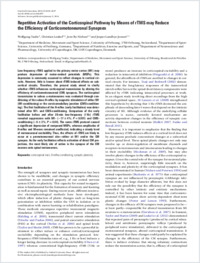Repetitive activation of the corticospinal pathway by means of rTMS may reduce the efficiency of corticomotoneuronal synapses
- Taube, Wolfgang Department of Medicine, Movement and Sport Science, University of Fribourg, Switzerland
- Leukel, Christian Department of Medicine, Movement and Sport Science, University of Fribourg, Switzerland - Department of Sport Science, University of Freiburg, Germany
- Nielsen, Jens Bo Department of Nutrition, Exercise and Sports, University of Copenhagen, Denmark - Department of Neuroscience and Pharmacology, University of Copenhagen, Denmark
- Lundbye-Jensen, Jesper Department of Nutrition, Exercise and Sports, University of Copenhagen, Denmark - Department of Neuroscience and Pharmacology, University of Copenhagen, Denmark
-
09.01.2014
Published in:
- Cerebral Cortex. - 2015, vol. 25, no. 6, p. 1629-1637
English
Low-frequency rTMS applied to the primary motor cortex (M1) may produce depression of motor-evoked potentials (MEPs). This depression is commonly assumed to reflect changes in cortical circuits. However, little is known about rTMS-induced effects on subcortical circuits. Therefore, the present study aimed to clarify whether rTMS influences corticospinal transmission by altering the efficiency of corticomotoneuronal (CM) synapses. The corticospinal transmission to soleus α-motoneurons was evaluated through conditioning of the soleus H-reflex by magnetic stimulation of either M1 (M1-conditioning) or the cervicomedullary junction (CMS-conditioning). The first facilitation of the H-reflex (early facilitation) was determined after M1- and CMS-conditioning. Comparison of the early facilitation before and after 20-min low-frequency (1 Hz) rTMS revealed suppression with M1- (−17 ± 4%; P = 0.001) and CMS-conditioning (−6 ± 2%; P = 0.04). The same rTMS protocol caused a significant depression of compound MEPs, whereas amplitudes of H-reflex and M-wave remained unaffected, indicating a steady level of motoneuronal excitability. Thus, the effects of rTMS are likely to occur at a premotoneuronal site—either at M1 and/or the CM synapse. As the early facilitation reflects activation of direct CM projections, the most likely site of action is the synapse of the CM neurons onto spinal motoneurons.
- Faculty
- Faculté des sciences et de médecine
- Department
- Département de Médecine
- Language
-
- English
- Classification
- Biological sciences
- License
- License undefined
- Identifiers
-
- RERO DOC 209511
- DOI 10.1093/cercor/bht359
- Persistent URL
- https://folia.unifr.ch/unifr/documents/303385
Statistics
Document views: 50
File downloads:
- bht359.pdf: 112
